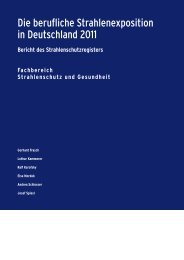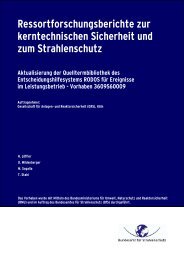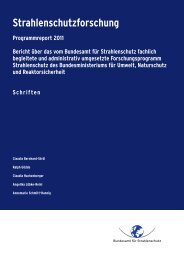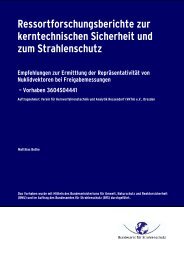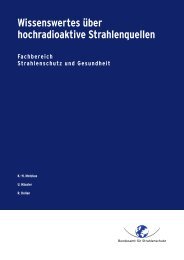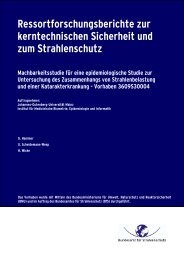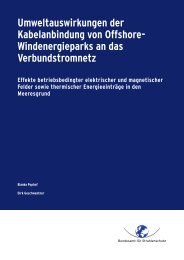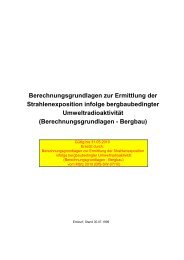Programmreport 2012 - DORIS - Bundesamt für Strahlenschutz
Programmreport 2012 - DORIS - Bundesamt für Strahlenschutz
Programmreport 2012 - DORIS - Bundesamt für Strahlenschutz
Sie wollen auch ein ePaper? Erhöhen Sie die Reichweite Ihrer Titel.
YUMPU macht aus Druck-PDFs automatisch weboptimierte ePaper, die Google liebt.
workers of the Wismut AG (3610S40007)“ conducted as case-control-study embedded in the Wismut-cohort<br />
relevant data had to be collected for about 600 persons. Informations of special interest are medical<br />
chest-x-rays due to routinely conducted examinations among uranium miners. Data collection comprised<br />
15 581 datasets on 640 persons.<br />
SUBJECT AREA 02 - RADIATION PROTECTION TECHNIQUES<br />
Phantoms are widely used within QC procedures of diagnostic X-ray equipment. Up to now no vendor-independent<br />
QA system for phantoms is established. Within the frame of the project “Development of procedures<br />
to determine the conformance of phantoms, used for quality assurance in radiography, with<br />
their specification in corresponding standards (3608S20001)“ non destructive test procedures were<br />
developed. Using these procedures it is possible to check the norm conformance of phantoms with adequate<br />
uncertainty. The test procedures have been used on a control sample from phantoms which are in clinical usage.<br />
Within these tests for an increased number of phantoms qualitative and quantitative faults have been<br />
found. It is to be assumed that in several cases the deviations within the phantoms have clear influence on<br />
the outcome of the tests.<br />
Active electronic personal dosemeters (EPD) are broadly used within personal dosimetry. Since some time it<br />
is known that the response of EPDs is dose rate dependent. At doses, which are too high for the EPD signal<br />
detection chain the response drops. The intention of the project “Dosimetry in pulsed X-ray fields using<br />
active electronic dosemeters (3610S20001)“ was to prove the usability of EPD for personal dosimetry<br />
within radiation diagnostics in human and veterinary medicine.<br />
The dose rate dependence of EPD of the device types Mk 2.3 and DMC2000X have been studied under laboratory<br />
conditions. It was found that at dose rates below about 1 Sv/h 1) the response of the EPDs was above<br />
80%, which was found suitable for their purpose.<br />
The maximum dose rate at all work places as well as whereabouts of assisting persons in human and veterinary<br />
medicine was estimated. The conservatism of the estimation was checked by measurements. In all but<br />
one cases the dose rate was clearly below 1 Sv/h. Thus, it is to be assumed that EPDs are fit for use in all<br />
working places in human and veterinary medicine.<br />
SUBJECT AREA 03 - RADIATION BIOLOGY - EFFECTS OF IONISING RADIATION, RADIOSENSITIVITY<br />
The organisers of the project “2nd Radiation Proteomics Workshop (3612S30032)“ on 30-31 January 2013<br />
in Neuherberg/Munich aimed to encourage the discussion between radiation biologists and proteomics specialists<br />
regarding new methods, challenges, state of the art and future co-operation in the field of radiation<br />
proteomics. During the intensive two days with lectures, posters, and information about the latest methodological<br />
highlights and challenges in proteomics, the status of radiation proteomics today was outlined and future<br />
goals speeding up the process of discovery of new molecular targets of ionising radiation were set. The focus<br />
of the discussions was: how could proteom analyses contribute to the issues individual radiation sensitivity,<br />
system effects of ionising radiation, biological effects of low dose and low dose rates and radiation effects on<br />
epigenetic mechanisms? In contrast to effects of high doses the health effects of low doses are still insufficiently<br />
explored. The investigation of the whole proteom with high throughput analyses could therefore provide<br />
new information about signaling pathways and mechanisms triggered by low dose ionising radiation in cells<br />
and organs. The workshop was organised by Helmholtz Center Munich and the Federal Office for Radiation<br />
Protection.<br />
SUBJECT AREA 04 - MEDICAL RADIATION EXPOSURES / X-RAY ORDINANCE<br />
In the first subproject of the research project “Physical optimisation and risk assessment of diagnostic<br />
and therapeutic procedures using ionising or non-ionising radiation (3608S04001)“ three functional imaging<br />
techniques were implemented and carefully optimised and validated for biologically-adapted radiotherapy<br />
using phantom experiments, namely (1.) H-1-Chemical-Shift-Imaging (H-1-CSI) at a 3-T-MRI system, (2.)<br />
dynamic positron emission tomography (PET) using F-18 fluorodeoxyglucose (FDG) in combination with (3.)<br />
dynamic contrast enhanced (DCE) CT at a modern hybrid PET/CT system. Due to the low spatial resolution<br />
1) The unit sievert per hour (Sv/h) is used to specify the measuring range of dosemeters. Pulsed fields apparently<br />
give rise to very high dose rates (in a range of several Sv/h). However, radiation exposure in fact occurs only<br />
during the short length of pulses which is in a range of milli- or microseconds<br />
XXI



